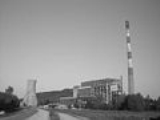
Ugljevik Power Plant
Encyclopedia
The Ugljevik Power Plant is a coal-fired power plant in Ugljevik
, Republic of Srpska, Bosnia and Herzegovina
. It is owned and operated by Rudnik i termoelektrana Ugljevik, a subsidiary of Elektroprivreda Republike Srpske
. RiTE Ugljevik is an integrated coal-mining and power generating company.
Construction of the second unit started in 1985 and halted during the Bosnian War
. During the war, the power plant was closed from April 1992 to November 1995, though the facilities and equipment were saved in expectation of resuming production.
In 2010, the power plant went through extensive upgrading.
 The Ugljevik Power Plant is now one of the largest generators of electricity in Republika Srpska. It has a combined heat and power generation unit with an installed capacity of 300 MW. In 2009, it generated 1,559 GWh of electricity and consumed 1.3 million tonnes of coal.
The Ugljevik Power Plant is now one of the largest generators of electricity in Republika Srpska. It has a combined heat and power generation unit with an installed capacity of 300 MW. In 2009, it generated 1,559 GWh of electricity and consumed 1.3 million tonnes of coal.
The power plant has a 310 metres (1,017.1 ft) tall flue gas stack
, the tallest structure in in Bosnia and Herzegovina
. Before the Bosnian War
on the top of chimney with big white letters was written 'TITO', in memory of communist leader of former Yugoslavia
Josip Broz Tito
. During the war text was rewritten, so now is visible a Serbian symbol, the Serbian cross
.
The company plans to open a new cola mine, Ugljevik-Istok. Some investors have showed interest in building a second unit with capacity of 600 MW of electricity.
Ugljevik
Ugljevik is a municipality and town in Bosnia and Herzegovina. The municipality located in the eastern foothills of Mount Majevica, in picturesque countryside, where wondrous and beautiful mountain starts descending towards the flatlands of Semberija, to which it is tied more than any other...
, Republic of Srpska, Bosnia and Herzegovina
Bosnia and Herzegovina
Bosnia and Herzegovina , sometimes called Bosnia-Herzegovina or simply Bosnia, is a country in Southern Europe, on the Balkan Peninsula. Bordered by Croatia to the north, west and south, Serbia to the east, and Montenegro to the southeast, Bosnia and Herzegovina is almost landlocked, except for the...
. It is owned and operated by Rudnik i termoelektrana Ugljevik, a subsidiary of Elektroprivreda Republike Srpske
Elektroprivreda Republike Srpske
Elektroprivreda Republike Srpske is a state-owned integrated power company in Republika Srpska, Bosnia and Herzegovina...
. RiTE Ugljevik is an integrated coal-mining and power generating company.
History
Ugljevik has been coal mining area since 1899. Construction of the coal-fired power plant started in 1976 and the first and only unit was commissioned in 1985. At the same time, the old Ugljevik coal mine was closed, the new Bogutovo Selo mine was opened, and the integrated coal-mining and power generating company RiTE Ugljevik was created on the base of Rudnik Ugljevik mining company.Construction of the second unit started in 1985 and halted during the Bosnian War
Bosnian War
The Bosnian War or the War in Bosnia and Herzegovina was an international armed conflict that took place in Bosnia and Herzegovina between April 1992 and December 1995. The war involved several sides...
. During the war, the power plant was closed from April 1992 to November 1995, though the facilities and equipment were saved in expectation of resuming production.
In 2010, the power plant went through extensive upgrading.
Description

The power plant has a 310 metres (1,017.1 ft) tall flue gas stack
Flue gas stack
A flue-gas stack is a type of chimney, a vertical pipe, channel or similar structure through which combustion product gases called flue gases are exhausted to the outside air. Flue gases are produced when coal, oil, natural gas, wood or any other fuel is combusted in an industrial furnace, a power...
, the tallest structure in in Bosnia and Herzegovina
Bosnia and Herzegovina
Bosnia and Herzegovina , sometimes called Bosnia-Herzegovina or simply Bosnia, is a country in Southern Europe, on the Balkan Peninsula. Bordered by Croatia to the north, west and south, Serbia to the east, and Montenegro to the southeast, Bosnia and Herzegovina is almost landlocked, except for the...
. Before the Bosnian War
Bosnian War
The Bosnian War or the War in Bosnia and Herzegovina was an international armed conflict that took place in Bosnia and Herzegovina between April 1992 and December 1995. The war involved several sides...
on the top of chimney with big white letters was written 'TITO', in memory of communist leader of former Yugoslavia
Yugoslavia
Yugoslavia refers to three political entities that existed successively on the western part of the Balkans during most of the 20th century....
Josip Broz Tito
Josip Broz Tito
Marshal Josip Broz Tito – 4 May 1980) was a Yugoslav revolutionary and statesman. While his presidency has been criticized as authoritarian, Tito was a popular public figure both in Yugoslavia and abroad, viewed as a unifying symbol for the nations of the Yugoslav federation...
. During the war text was rewritten, so now is visible a Serbian symbol, the Serbian cross
Serbian cross
The Serbian Cross is a national symbol of Serbia, part of the Coat of Arms of Serbia, and the flag of Serbia. It is composed of a cross symbol with four C-shapes on each of its corners, in use as a national emblem since the 14th century....
.
The company plans to open a new cola mine, Ugljevik-Istok. Some investors have showed interest in building a second unit with capacity of 600 MW of electricity.
See also
- List of tallest structures in the world
- List of tallest buildings and structures in the world by country
- List of tallest structures in former Yugoslavia
External links
- Official Website
- Another website of RiTE Ugljevik
- Official website of Ugljevik Municipality
- Ugljevik Info page
- http://www.skyscraperpage.com/cities/?buildingID=54040

